
When the lights flicker out and you’re plunged into darkness, having a power outage survival kit can turn a stressful situation into a manageable one. Welcome to our guide to creating the ultimate emergency kit for your home. It’s not just about candles and flashlights; it’s about being thoroughly prepared. In this guide, we’ll walk you through an essential emergency kit list and learn how to stay safe and warm during unexpected power outages. Whether it’s a stormy night or a grid failure, with this kit, you’ll have everything you need to weather the blackout comfortably and securely. Let’s ensure you’re never caught off guard when the power goes out.

When winter sets in, the likelihood of power outages increases significantly. Understanding the causes and impacts of these outages is crucial for homeowners. Always be prepared with these 25 Emergency Kit Ideas.
Causes of Power Outages
- Causes of Winter Power Outages:
- Winter Storms: Heavy snowfall, ice accumulation, and high winds can damage power lines and equipment.
- Power Grid Failures:
- Surges in electricity demand during frigid temperatures can overwhelm the power grid.
- Equipment malfunctions, often worsened by the cold, can lead to outages.
- Man-Made Disasters: Accidents or equipment failures, such as a vehicle damaging a transformer.
- Impact on Homes:
- Loss of Heating: During frigid temperatures, homes can quickly lose heat without electricity, becoming uncomfortable and unsafe.
- Disrupted Daily Life: Outages affect lighting, heating, and the operation of essential appliances.
- Safety Risks: In inclement weather, the absence of heat can pose health hazards, especially in extremely cold regions.
Understanding these factors helps homeowners prepare and respond effectively to power outages during the winter months. By recognizing the potential causes, such as winter storms and power grid failures, you can take proactive steps to mitigate their impact on your home.
More Survival Kit Ideas
- Zombie Survival Kit: Have fun with this fun gift!
- Car Emergency Survival Kit: Don’t get caught in the car during an emergency without this kit.
- First Aid Survival Kit: Make a first aid kit for all emergency situations!
- Teacher Survival Kit
What To Do When The Power Goes Out
When the power goes out in your house, there are several steps you should take to ensure your safety and comfort during the outage:
- Check the Scope of the Outage: Verify whether the power outage is limited to your home or if it’s a wider area issue. If it’s just your home, check your circuit breakers or fuse box.
- Use Flashlights, Not Candles: For lighting, rely on flashlights or battery-operated lanterns instead of candles to minimize the risk of fire.
- Unplug Electrical Appliances: Unplug electronics and appliances to prevent damage from a power surge when the electricity comes back on. Leave one light on so you know when the power is restored.
- Keep Refrigerator and Freezer Closed: To keep food cold, avoid opening the refrigerator and freezer. A full freezer can keep the temperature for about 48 hours if unopened.
- Stay Informed: Use a battery-powered or hand-crank radio to stay updated on the power outage situation and weather reports.
- Stay Cool or Warm: Depending on the season, take steps to remain cool or warm. In summer, stay in the coolest part of the house. In winter, wear layers of warm clothing and use blankets.
- Conserve Water: If you rely on an electric pump for water, use water sparingly.
- Use Generators Safely: If you have a portable generator, use it outside only, away from windows, to avoid carbon monoxide poisoning.
- Check on Neighbors: Especially the elderly or those who may need extra help.
- Avoid Opening the Garage Door Manually: If possible, to prevent potential damage.
Remember, safety is the most important consideration during a power outage. Being prepared with items like flashlights, extra batteries, and a first aid kit can make a significant difference.
Essential Items For Your Power Outage Kit
When winter rolls in, so does the potential for power outages. Being caught unprepared in winter weather can be more than just inconvenient; it can be dangerous. That’s why having a winter weather power outage survival kit is essential. This kit should include everything you need to stay safe, warm, and fed until power is restored. Here’s what to pack:
1. Bottled Water: Always have a 3-day emergency supply. Having enough water is the most important thing to have. That’s about one gallon per person, per day. A 3-day emergency supply of water is usually best in water bottles, which can store longer than other water sources.
2. Non-Perishable Food: Stock up on canned goods, energy bars, dried fruits, and nuts. These foods don’t require cooking and will stay good for a long time.
3. First Aid Kit: A first-aid kit should include basic supplies and any prescription medication you or family members might need.
4. Flashlights and Extra Batteries: Having alternative light sources is imperative. A reliable flashlight with extra batteries is vital for navigating your home safely when the lights go out. Light sticks are also a good temporary solution.
5. Battery-Powered or Hand-Crank Radio: Keep informed about the weather and emergency broadcasts with a battery-powered radio or a hand-crank radio.
6. Warm Clothing: Layering is key in cold weather. Warm clothes should include thermal underwear, hats, gloves, and socks to retain body heat.
7. Blankets and Sleeping Bags: These are essential for staying warm, especially at night when temperatures drop. A sleeping bag is designed to retain body heat, making them a valuable addition to your winter power outage survival kit.
8. Portable Heat Source: If safe to use, items like propane heaters, or a kerosene heater can provide warmth. Always follow safety guidelines to prevent fire hazards. Do not use charcoal grills or gas grills indoors.
9. Extra Fuel: If you have a wood-burning stove or fireplace, keep an extra supply of wood or coal.
10. Emergency Contact Information: Have a list of emergency contacts and local shelters.
11. Candles and Matches: In case batteries run out, candles can provide light and a bit of warmth. Use them cautiously.
12. Multi-Tool or Swiss Army Knife: The versatile nature of a multi-tool can come in handy for various tasks.
13. Portable Power Bank: Portable power banks keep your phone charged in case you need to make emergency calls. You will need to keep this charged up frequently to make sure it’s available in case of a power outage. A basica power outage emergency kit should always include a portable power source that will not be affected by the power failure.
14. Entertainment: Books, board games, or a deck of cards can help pass the time and keep spirits up.
15. Personal Hygiene Items: Include items like toothpaste, toothbrushes, and wet wipes.
16. Cash: It’s a good idea to have on hand in case you need to make purchases when credit card machines are down.
Preparing a winter weather power outage survival kit might seem like a lot, but it’s all about ensuring you and your loved ones stay safe and comfortable during winter weather. Remember, it’s always better to be over-prepared than under-prepared when it comes to power outages in cold weather. Stay warm, stay safe, and stay prepared!
Keeping Warm Safely
When the temperature plummets and you’re faced with a winter power outage, staying warm safely is a top priority. The cold can be more than uncomfortable; it can be dangerous, especially without the usual comforts of central heating. Here are some tips on how to keep warm, while keeping safety in mind.
1. Layer Up with Warm Clothing:
- Warm clothing layers are your first defense against the cold.
- Thermal underwear, woolen socks, and layered clothing trap warm air close to the body.
- Don’t forget hats and gloves, especially for young children.
2. Use Safe Heat Sources:
- Wood-burning stoves and fireplaces are great, as long as they’re properly vented.
- Portable heaters, like propane heaters or kerosene heaters, are a great option. But remember, they need adequate ventilation to prevent carbon monoxide buildup.
3. Be Carbon Monoxide Smart:
- Never use a grill or gas stove indoors for heat. They can emit carbon monoxide, a deadly, toxic gas.
- Always have a battery-operated carbon monoxide detector in use.
4. Insulate Your Home:
- Seal up drafts around doors and windows.
- Hang blankets over windows at night to keep warm air in.
5. Heat Small Spaces:
- It’s easier to heat a small room or area of your home.
- Gather the family in one room and close the door to keep heat concentrated.
6. Stay Active:
- Light activity can help generate body heat. But don’t overdo it, as sweating can make you colder when you stop moving.
7. Use Sleeping Bags and Blankets:
- Sleeping bags designed for cold temperatures are excellent for retaining heat.
- Pile on extra blankets, especially at night.
8. Hydrate and Eat Well:
- Eating and drinking can help your body generate heat. Opt for warm drinks and high-energy foods.
9. Shared Body Heat:
- Don’t underestimate the power of shared body heat. Huddle together with family members under blankets.
10. Safety First with Heaters:
- Keep portable heaters away from flammable materials.
- Turn off heaters when leaving the room or going to sleep.
11. Avoid Alcohol:
- While it might feel warming, alcohol can lower your body’s core temperature.
12. Check on Vulnerable Neighbors:
- Make sure elderly or vulnerable neighbors are safe and warm.
Keeping warm during a winter power outage requires a balance of practicality and precaution. By layering clothing, using safe heating methods, and staying vigilant about the risks of carbon monoxide and fire, you can stay warm and safe until the power comes back on. Remember, preparation and knowledge are key to weathering a winter outage comfortably and safely.
Food and Water Necessities
When the lights go out and you’re facing an extended power outage, having the right food supplies and water supply in your emergency kit isn’t just convenient, it’s essential. Let’s break down what you should have on hand to ensure you’re well-fed and hydrated, even when the power grid lets you down.
Stocking Up on Water:
- Bottled Water: The golden rule? One gallon per person, per day. This should cover drinking and basic sanitation needs.
- If space allows, stock up enough for at least three days.
Choosing the Right Foods:
- Non-perishable food is your best friend during a power outage. Think canned vegetables, fruit, beans, and meats.
- Don’t forget a manual can opener! It’s a small tool, but without it, those canned goods aren’t much use.
- Dried foods like nuts, trail mix, and jerky are great for snacking.
- Bread, crackers, and cereal can last longer than you think, especially if stored properly.
- For those with a sweet tooth, energy bars and dried fruits can give you a quick energy boost.
Water Safety:
- If you’re unsure about your water supply’s safety post-outage, boil water before consuming.
- Alternatively, water purification tablets can be a handy backup.
Preparing for a power outage doesn’t have to be a daunting task. By ensuring your emergency kit is stocked with sufficient bottled water and a variety of non-perishable food, you’ll be in a good position to ride out the outage comfortably and safely. Remember, preparation is key, and a well-stocked pantry is the first step in power outage readiness.
Storage and Maintanence
When you’re prepping for the unexpected, like a power grid failure, the way you store and maintain your emergency supplies is as crucial as the items themselves. Your winter power outage survival kit is your lifeline during those dark, chilly hours, so let’s talk about keeping it in tip-top shape.
Location, Location, Location: Store your kit in a cool, dry place that’s easily accessible. Avoid basements that might flood or attics that can become overly hot. Think about a dedicated closet shelf or a storage bench that’s part of your living space.
Check and Rotate: Regular maintenance is key. Every six months, go through your kit. Check expiration dates on food, water, batteries, and first aid supplies. Rotate items out as needed. It’s a good habit to align this check-up with daylight saving time changes.
Keep It Organized: Use clear, waterproof containers for storage. Label everything clearly. It helps if you need to send someone else to grab the kit in a hurry.
Functionality Check: Periodically check that everything works. Test flashlights and radios. Make sure matches are dry and that multi-tools or can openers are rust-free.
Stay Updated: As your family’s needs change, so should your kit. Maybe you need to add baby supplies or pet food. Update your kit to reflect the current needs of your household.
In short, a well-stored and maintained winter power outage survival kit is a critical part of preparing for power grid failures. With a little organization and regular check-ins, you’ll have peace of mind knowing you’re ready for whatever Mother Nature throws your way.
Frequently Asked Questions
Yes, you can use kerosene space heaters indoors, but it’s crucial to do so with caution and adherence to safety guidelines. Kerosene heaters can be an effective source of heat during power outages or in areas without central heating. However, they come with risks, especially concerning ventilation and fire safety. Here are some key points to consider:
Ventilation: Kerosene heaters consume oxygen and emit carbon monoxide, a toxic gas. Ensure the room is well-ventilated to prevent carbon monoxide buildup.
Fuel: Use only 1-K grade kerosene and never gasoline or other fuels. Incorrect fuel can increase the risk of fire and release harmful gases.
Placement: Position the heater away from furniture, curtains, and other flammable materials. Keep it on a stable, flat surface to prevent tipping. Kerosene heaters can be a fire hazard if you aren’t careful.
Maintenance: Regularly clean and maintain the heater according to the manufacturer’s instructions to ensure it operates safely and efficiently.
Carbon Monoxide Detector: Have a battery-operated carbon monoxide detector in the room where the heater is used.
Supervision: Never leave a kerosene heater unattended, especially when sleeping or leaving the house.
Local Regulations: Check local regulations and guidelines, as some areas have restrictions or specific safety codes regarding the use of kerosene heaters indoors.
By following these safety precautions, you can use kerosene heaters indoors more safely. However, always prioritize safety and consider alternative heating options if possible.
Additional safety information about using kerosene heaters indoors.
Yes, you can use propane heaters indoors, but it’s important to ensure they are designed for indoor use and to follow strict safety guidelines. Propane heaters emit carbon monoxide and consume oxygen, so proper ventilation and adherence to safety measures are critical. Here’s what you need to consider:
Indoor-Safe Models: Only use propane heaters that are specifically designed and approved for indoor use. These models typically have built-in safety features like oxygen depletion sensors (ODS).
Ventilation: Even with indoor-safe models, ensure the room is well-ventilated to avoid the buildup of carbon monoxide, a dangerous, odorless gas.
Placement: Keep the heater away from flammable materials like curtains, furniture, or bedding. Place it on a stable, non-flammable surface.
Carbon Monoxide Detectors: Install battery-operated carbon monoxide detectors in your home, especially near sleeping areas, to detect any dangerous accumulation of gas.
Follow Instructions: Read and adhere to the manufacturer’s instructions for operation and maintenance.
Never Leave Unattended: Avoid using propane heaters while sleeping and never leave them unattended.
Check Local Regulations: Be aware of any local laws or regulations regarding the use of propane heaters indoors.
Regular Maintenance: Regularly check and maintain your heater to ensure it’s in good working condition.
Avoid Using in Confined Spaces: Do not use propane heaters in small, confined spaces like bathrooms or bedrooms.
Adequate Supply of Fresh Air: Ensure there is a sufficient supply of fresh air circulating in the area where the heater is used.
Remember, while propane heaters can be a good source of heat during cold weather or power outages, safety should always be your top priority. If you’re unsure about using a propane heater safely, consider alternative heating methods.
Additional information on the safe use of propane heaters indoors.
Ever wondered if you can still flush your toilet when the power goes out? Well, here’s some good news! In most cases, yes, you can. The toilet doesn’t rely on electricity to function. It operates through a plumbing system that’s independent of your power supply. The key factor here is the water pipes. As long as they’re not frozen and water is available in your system, you should be able to flush normally. So, even in a power outage, your toilet should work just fine. Just remember, if water supply is limited, use each flush wisely!

Power Outage Survival Kit
Supplies
- bottled water 1 gallon per day for each person for a minimum of 3 days.
- non-perishable food Canned goods, energy bars, dried fruits and nuts. No foods that require cooking. Include a can opener if necessary.
- first aid kit
- flashlights include extra batteries.
- warm clothing
- blankets and sleeping bags
- portable heat source Be safe, only use heaters that should be used indoors. Use according to directions. Include extra fuel.
- emergency contact info
- candles and matches In case of extended power outage when batteries die.
- multi-tool or swiss ormy knife
- portable power source Keep it powered up in case of emergency.
- entertainment books and games
- personal hygiene items wet wipes, toothbrushes, toothpaste
- cash
Instructions
- Place all your power outage emergency kit in a waterproof container that will be accessible in case of an emergency.
Notes
-
Lighting Safely:
- Use flashlights or battery-operated lanterns.
- Avoid candles to reduce the risk of fire.
-
Food Safety:
- Keep the refrigerator and freezer closed to preserve food.
-
Generator Use:
- Operate generators outside to prevent carbon monoxide poisoning.
-
Protect Electronics:
- Unplug appliances and electronics to avoid damage from power surges.
-
Community Care:
- Check on neighbors, especially those who may need additional assistance.
Love This Project?
Make sure to share it with me on Instagram @andreasnotebook and follow on Pinterest @andreasnotebook for more!
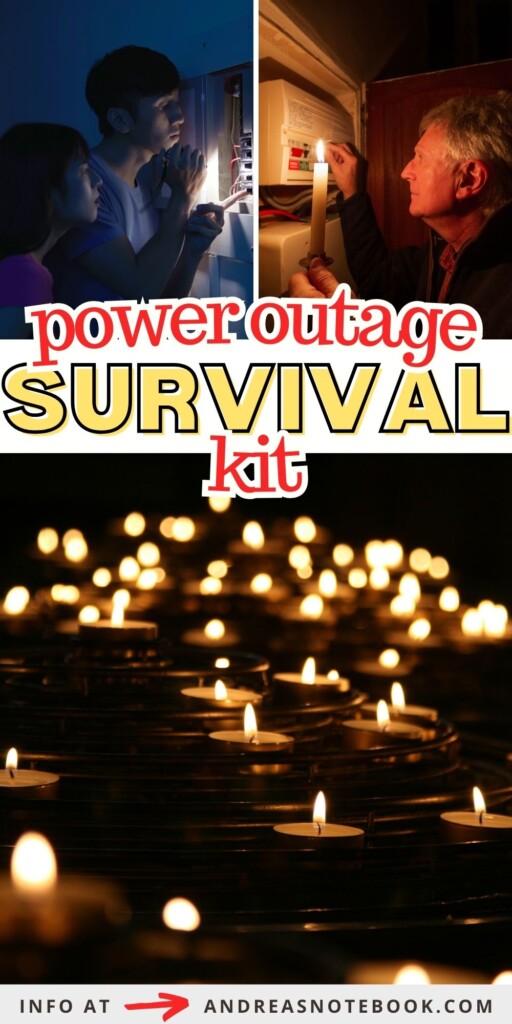
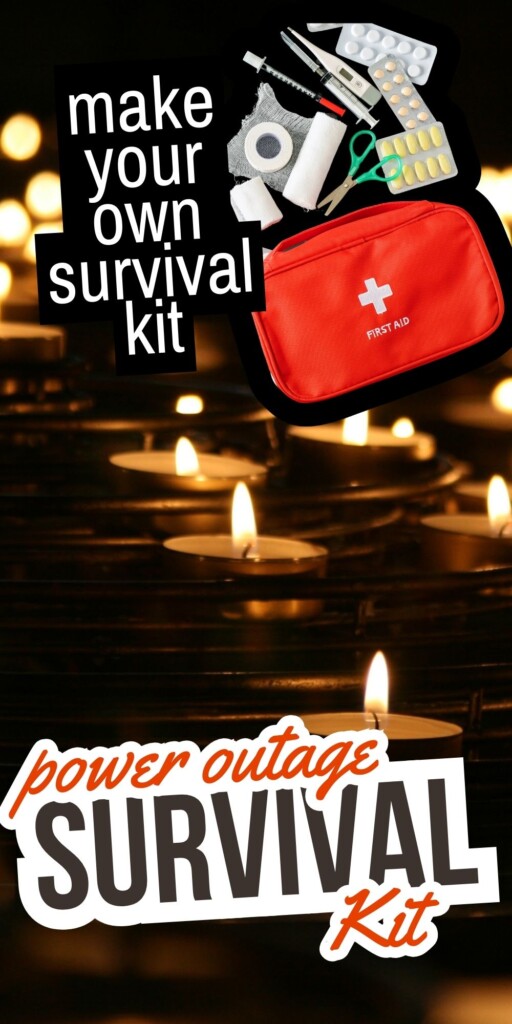
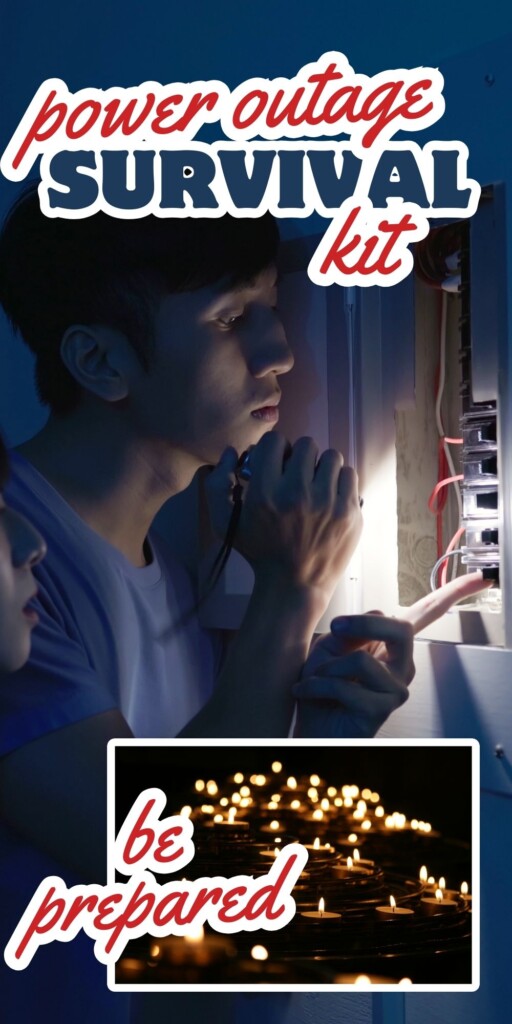
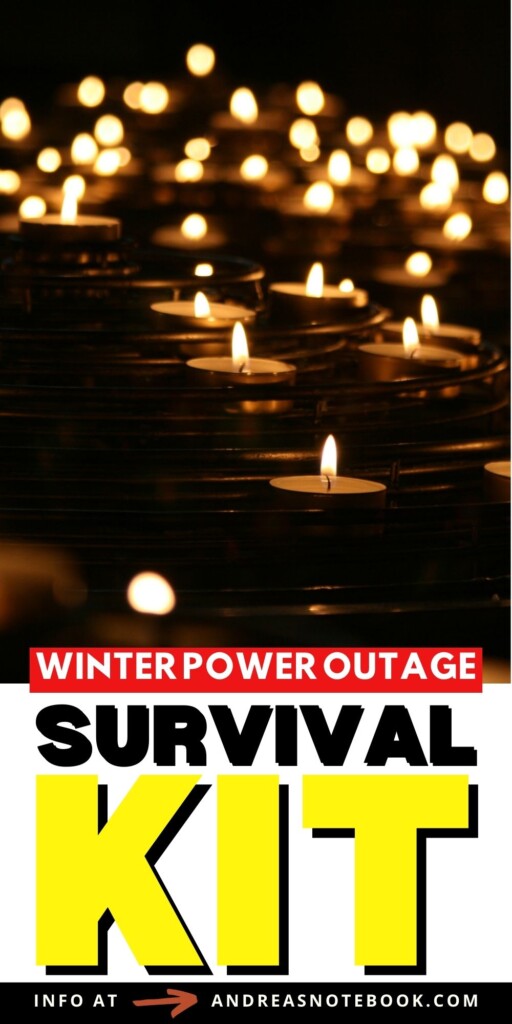
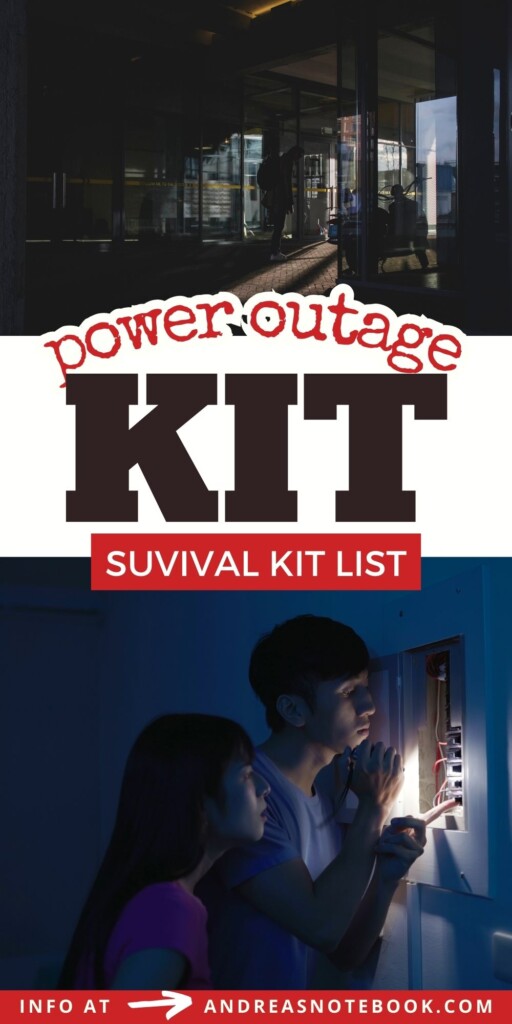


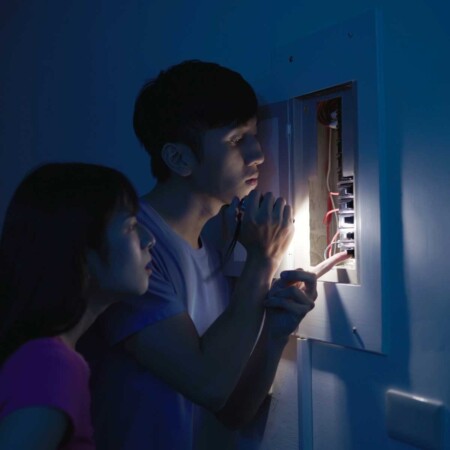
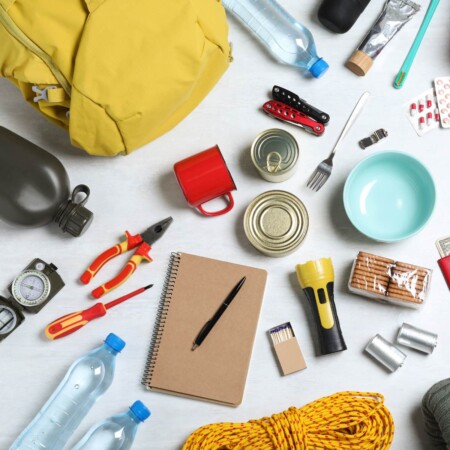


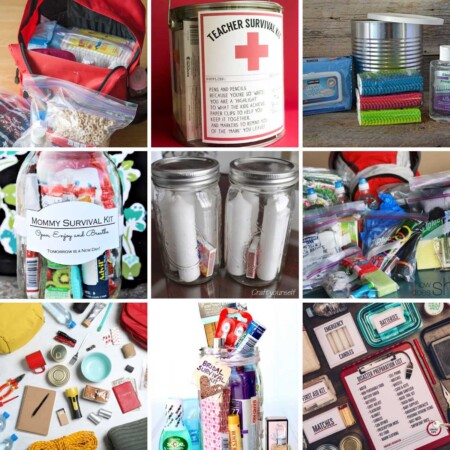
Comments & Reviews
Nick says
I’m in Texas. Making this. Need I say more?